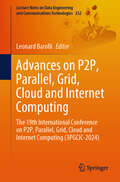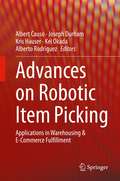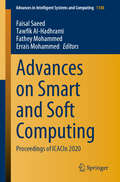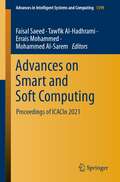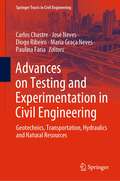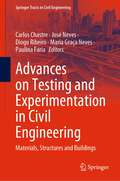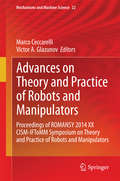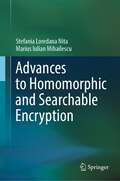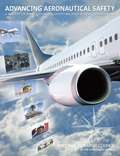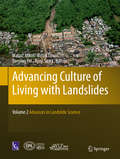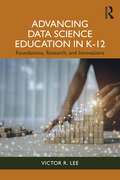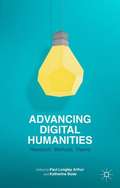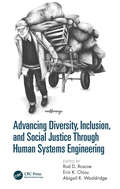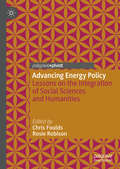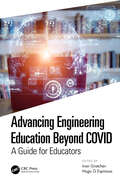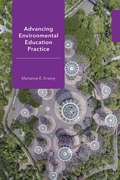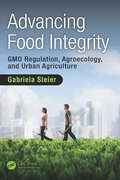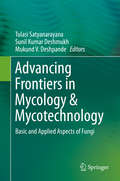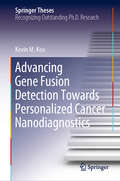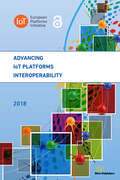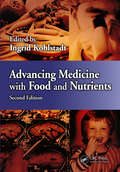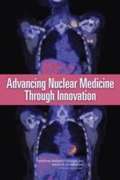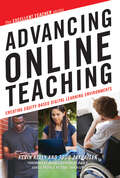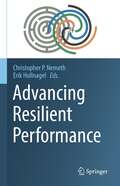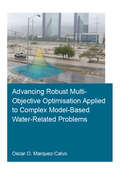- Table View
- List View
Advances on P2P, Parallel, Grid, Cloud and Internet Computing: The 19th International Conference on P2P, Parallel, Grid, Cloud and Internet Computing (3PGCIC-2024) (Lecture Notes on Data Engineering and Communications Technologies #232)
by Leonard BarolliThis book aims to provide the latest research findings, innovative research results, methods, and development techniques from both theoretical and practical perspectives related to P2P, Parallel, Grid, Cloud, and Internet computing and to reveal synergies among such large-scale computing paradigms. P2P, Grid, Cloud, and Internet computing technologies have been very fast established as breakthrough paradigms for solving complex problems by enabling aggregation and sharing of an increasing variety of distributed computational resources at large scale. Grid Computing originated as a paradigm for high-performance computing, as an alternative to expensive supercomputers through different forms of large-scale distributed computing. P2P Computing emerged as a new paradigm after client-server and web-based computing and has shown useful to the development of social networking, business to business (B2B), business to consumer (B2C), business to government (B2G), business to employee (B2E), and so on. Parallel Computing is an essential computational paradigm for solving complicated problems quickly. It divides a scientific computing problem into several small computing tasks and concurrently runs these tasks by utilizing parallel hardware and overcoming the memory constraint. Parallel computing is an important part of cloud environment. However, there are significant differences between cloud computing and parallel computing. Cloud Computing has been defined as a “computing paradigm where the boundaries of computing are determined by economic rationale rather than technical limits”. Cloud computing has fast become the computing paradigm with applicability and adoption in all application domains and providing utility computing at large scale. Finally, Internet Computing is the basis of any large-scale distributed computing paradigms; it has very fast developed into a vast area of flourishing field with enormous impact on today’s information societies serving thus as a universal platform comprising a large variety of computing forms such as Grid, P2P, Cloud, and mobile computing.
Advances on Robotic Item Picking: Applications in Warehousing & E-Commerce Fulfillment
by Albert Causo Joseph Durham Kris Hauser Kei Okada Alberto RodriguezThis book is a compilation of advanced research and applications on robotic item picking and warehouse automation for e-commerce applications. The works in this book are based on results that came out of the Amazon Robotics Challenge from 2015-2017, which focused on fully automated item picking in a warehouse setting, a topic that has been assumed too complicated to solve or has been reduced to a more tractable form of bin picking or single-item table top picking. The book’s contributions reveal some of the top solutions presented from the 50 participant teams. Each solution works to address the time-constraint, accuracy, complexity, and other difficulties that come with warehouse item picking. The book covers topics such as grasping and gripper design, vision and other forms of sensing, actuation and robot design, motion planning, optimization, machine learning and artificial intelligence, software engineering, and system integration, among others. Through this book, the authors describe how robot systems are built from the ground up to do a specific task, in this case, item picking in a warehouse setting. The compiled works come from the best robotics research institutions and companies globally.
Advances on Smart and Soft Computing: Proceedings of ICACIn 2020 (Advances in Intelligent Systems and Computing #1188)
by Faisal Saeed Fathey Mohammed Tawfik Al-Hadhrami Errais MohammedThis book gathers high-quality papers presented at the First International Conference of Advanced Computing and Informatics (ICACIn 2020), held in Casablanca, Morocco, on April 12–13, 2020. It covers a range of topics, including artificial intelligence technologies and applications, big data analytics, smart computing, smart cities, Internet of things (IoT), data communication, cloud computing, machine learning algorithms, data stream management and analytics, deep learning, data mining applications, information retrieval, cloud computing platforms, parallel processing, natural language processing, predictive analytics, knowledge management approaches, information security, security in IoT, big data and cloud computing, high-performance computing and computational informatics.
Advances on Smart and Soft Computing: Proceedings of ICACIn 2021 (Advances in Intelligent Systems and Computing #1399)
by Faisal Saeed Tawfik Al-Hadhrami Errais Mohammed Mohammed Al-SaremThis book presents the papers included in the proceedings of the 2nd International Conference of Advanced Computing and Informatics (ICACIn’21) that was held in Casablanca, Morocco, on May 24–25, 2021. The main theme of the book is “Advances on Smart and Soft Computing.” A total of 71 papers were submitted to the conference, but only 44 papers were accepted and published in this book. The book presents several hot research topics which include artificial intelligence and data science, big data analytics, Internet of Things (IoT), information security, cloud computing, networking and computational informatics.
Advances on Testing and Experimentation in Civil Engineering: Geotechnics, Transportation, Hydraulics and Natural Resources (Springer Tracts in Civil Engineering)
by José Neves Diogo Ribeiro Carlos Chastre Maria Graça Neves Paulina FariaThe book presents the recent advances on testing and experimentation in civil engineering, especially in the branches of geotechnics, transportation, hydraulics, and natural resources. It includes advances in physical modelling, monitoring techniques, data acquisition and analysis, and provides an invaluable contribution for the installation of new civil engineering experimental facilities. The first part of the book covers the latest advances in testing and experimentation in key domains of geotechnics: soil mechanics and geotechnical engineering, rock mechanics and rock engineering, and engineering geology. Some of the topics covered include new developments in topographic survey acquisition for applied mapping and in situ geotechnical investigations; laboratory and in situ tests to estimate the relevant parameters needed to model the behaviour of rock masses and land structures; monitoring and inspection techniques designed for offshore wind foundations. The second part of the book highlights the relevance of testing and monitoring in transportation. Full-scale accelerated pavement testing, and instrumentation becomes even more important nowadays when, for sustainability purposes, non-traditional materials are used in road and airfield pavements. Innovation in testing and monitoring pavements and railway tracks is also developed in this part of the book. Intelligent traffic systems are the new traffic management paradigm, and an overview of new solutions is addressed here. Finally, in the third part of the book, trends in the field and laboratory measurements and corresponding data analysis are presented according to the different hydraulic domains addressed in this publication, namely maritime hydraulics, surface water and river hydraulics and urban water.
Advances on Testing and Experimentation in Civil Engineering: Materials, Structures and Buildings (Springer Tracts in Civil Engineering)
by José Neves Diogo Ribeiro Carlos Chastre Maria Graça Neves Paulina FariaThis book presents the most recent advances on testing and experimentation in civil engineering, especially in the branches of materials, structures, and buildings, complementing the authors’ publication Advances on Testing and Experimentation in Civil Engineering - Geotechnics, Transportation, Hydraulics and Natural Resources. It includes advances in physical modelling, monitoring techniques, data acquisition and analysis, and provides an invaluable contribution to the installation of new civil engineering experimental facilities. The first part of the book covers the latest advances in the testing and experimentation of key domains of materials, such as bio-cementation and self-healing, durability, and recycled materials, as well as the new environmental requirements related to the presence of hazardous substances in construction materials. Furthermore, laboratory and in situ tests, together with equipment needed to estimate the behaviour and durability of construction materials are presented, updating the most important technological advances. The second part of the book highlights the relevance of testing and monitoring in structures, including in situ tests related to static load tests, dynamic tests, and long-term monitoring strategies, as well as laboratory tests of adhesive joints. Experimental tests on shake tables and blast-resistant structures are also described. Recent applications of drone technologies for the inspection and monitoring of civil structures are another important theme developed. Finally, in its third part, the book presents new developments in the characterisation of building testing, with the support of modelling, to assess building pathology and new requirements, acoustic comfort, fire safety, visual comfort, and energy consumption.
Advances on Theory and Practice of Robots and Manipulators: Proceedings of Romansy 2014 XX CISM-IFToMM Symposium on Theory and Practice of Robots and Manipulators (Mechanisms and Machine Science #22)
by Marco Ceccarelli Victor A. GlazunovThis proceedings volume contains papers that have been selected after review for oral presentation at ROMANSY 2014, the 20th CISM-IFToMM Symposium on Theory and Practice of Robots and Manipulators. These papers cover advances on several aspects of the wide field of Robotics as concerning Theory and Practice of Robots and Manipulators. ROMANSY 2014 is the twentieth event in a series that started in 1973 as one of the first conference activities in the world on Robotics. The first event was held at CISM (International Centre for Mechanical Science) in Udine, Italy on 5-8 September 1973. It was also the first topic conference of IFToMM (International Federation for the Promotion of Mechanism and Machine Science) and it was directed not only to the IFToMM community. Proceedings volumes of ROMANSY have been always published to be available, also after the symposium, to a large public of scholars and designers with the aim to give an overview of new advances and trends in the theory, design and practice of robots. This proceedings volume, like previous ones of the series, contains contributions with achievements covering many fields of Robotics as Theory and Practice of Robots and Manipulators that can be an inspiration for future developments.
Advances to Homomorphic and Searchable Encryption
by Stefania Loredana Nita Marius Iulian MihailescuThis book presents the current state of the literature on the fields of homomorphic and searchable encryption, from both theoretical and practical points of view. Homomorphic and searchable encryption are still relatively novel and rapidly evolving areas and face practical constraints in the contexts of large-scale cloud computing and big data.Both encryption methods can be quantum-resistant if they use the right mathematical techniques. In fact, many fully homomorphic encryption schemes already use quantum-resistant techniques, such as lattices or characteristics of polynomials – which is what motivated the authors to present them in detail.On the one hand, the book highlights the characteristics of each type of encryption, including methods, security elements, security requirements, and the main types of attacks that can occur. On the other, it includes practical cases and addresses aspects like performance, limitations, etc. As cloud computing and big data already represent the future in terms of storing, managing, analyzing, and processing data, these processes need to be made as secure as possible, and homomorphic and searchable encryption hold huge potential to secure both the data involved and the processes through which it passes.This book is intended for graduates, professionals and researchers alike. Homomorphic and searchable encryption involve advanced mathematical techniques; accordingly, readers should have a basic background in number theory, abstract algebra, lattice theory, and polynomial algebra.
Advancing Aeronautical Safety: A Review of NASA's Aviation Safety-Related Research Programs
by National Research Council of the National AcademiesAdvancing the state of aviation safety is a central mission of the National Aeronautics and Space Administration (NASA). Congress requested this review of NASA's aviation safety-related research programs,seeking an assessment of whether the programs have well-defined,prioritized,and appropriate research objectives; whether resources have been allocated appropriately among these objectives; whether the programs are well coordinated with the safety research programs of the Federal Aviation Administration; and whether suitable mechanisms are in place for transitioning the research results into operational technologies and procedures and certification activities in a timely manner. Advancing Aeronautical Safety contains findings and recommendations with respect to each of the main aspects of the review sought by Congress. These findings indicate that NASA's aeronautics research enterprise has made,and continues to make,valuable contributions to aviation system safety but it is falling short and needs improvement in some key respects.
Advancing Culture of Living with Landslides: Volume 2 Advances in Landslide Science
by Kyoji Sassa Yueping Yin Matjaz Mikos Binod TiwariThis volume contains peer-reviewed papers from the Fourth World Landslide Forum organized by the International Consortium on Landslides (ICL), the Global Promotion Committee of the International Programme on Landslides (IPL), University of Ljubljana (UL) and Geological Survey of Slovenia in Ljubljana, Slovenia from May 29 to June 2,. The complete collection of papers from the Forum is published in five full-color volumes. This second volume contains the following: * Two keynote lectures * Landslide Field Recognition and Identification: Remote Sensing Techniques, Field Techniques * Landslide Investigation: Field Investigations, Laboratory Testing * Landslide Modeling: Landslide Mechanics, Simulation Models * Landslide Hazard Risk Assessment and Prediction: Landslide Inventories and Susceptibility, Hazard Mapping Methods, Damage Potential Prof. Matjaž Mikos is the Forum Chair of the Fourth World Landslide Forum. He is the Vice President of International Consortium on Landslides and President of the Slovenian National Platform for Disaster Risk Reduction. Prof. Binod Tiwari is the Coordinator of the Volume 2 of the Fourth World Landslide Forum. He is a Board member of the International Consortium on Landslides and an Executive Editor of the International Journal "Landslides". He is the Chair-Elect of the Engineering Division of the US Council of Undergraduate Research, Award Committee Chair of the American Society of Civil Engineering, Geo-Institute's Committee on Embankments, Slopes, and Dams Committee. Prof. Yueping Yin is the President of the International Consortium on Landslides and the Chairman of the Committee of Geo-Hazards Prevention of China, and the Chief Geologist of Geo-Hazard Emergency Technology, Ministry of Land and Resources, P. R. China. Prof. Kyoji Sassa is the Founding President of the International Consortium on Landslides (ICL). He is Executive Director of ICL and the Editor-in-Chief of International Journal"Landslides" since its foundation in 2004. IPL (International Programme on Landslides) is a programme of the ICL. The programme is managed by the IPL Global Promotion Committee including ICL and ICL supporting organizations, UNESCO, WMO, FAO, UNISDR, UNU, ICSU, WFEO, IUGS and IUGG. The IPL contributes to the United Nations International Strategy for Disaster Reduction and the ISDR-ICL Sendai Partnerships 2015-2025.
Advancing Data Science Education in K-12: Foundations, Research, and Innovations
by Victor R. LeeAdvancing Data Science Education in K-12 offers a highly accessible, research-based treatment of the foundations of data science education and its increasingly vital role in K-12 instructional content.As federal education initiatives and developers of technology-enriched curricula attempt to incorporate the study of data science—the generation, capture, and computational analysis of data at large scale—into schooling, a new slate of skills, literacies, and approaches is needed to ensure an informed, effective, and unproblematic deployment for young learners. Friendly to novices and experts alike, this book provides an authoritative synthesis of the most important research and theory behind data science education, its implementation into K-12 curricula, and clarity into the distinctions between data literacy and data science. Learning with and about data hold equal and interdependent importance across these chapters, conveying the variety of issues, situations, and decision-making integral to a well-rounded, critically minded perspective on data science education.Students and faculty in teaching, leadership, curriculum development, and educational technology programs will come away with essential insights into the breadth of our current and future engagements with data; the real-world opportunities and challenges data holds when taught in conjunction with other subject matter in formal schooling; and the nature of data as a human and societal construct that demands new competencies of today’s learners.
Advancing Digital Humanities
by Paul Longley Arthur Katherine BodeAdvancing Digital Humanities moves beyond definition of this dynamic and fast growing field to show how its arguments, analyses, findings and theories are pioneering new directions in the humanities globally.
Advancing Diversity, Inclusion, and Social Justice Through Human Systems Engineering
by Rod D. Roscoe Erin K. Chiou Abigail R. WooldridgeWinner of the "Outstanding Academic Title" recognition by Choice for the 2020 OAT Awards. The Choice OAT Award represents the highest caliber of scholarly titles that have been reviewed by Choice and conveys the extraordinary recognition of the academic community.Advancing Diversity, Inclusion, and Social Justice through Human Systems Engineering highlights how scholars and practitioners of HSE (inclusively defined to span many fields) can apply their theories and methods to understand and support healthy communities, include and empower diverse populations, and inspire strategies for a more inclusive future. This volume brings together experts from human factors, ergonomics, psychology, human-computer interaction, and more to demonstrate how these fields can be applied to societal challenges and solutions. Through a blend of research reports, literature reviews, and personal narratives, this volume explores these issues from the individual to the global scale, across diverse populations, and across multiple continents. Features Draws upon human factors and ergonomics theories and methods to evaluate, understand, and confront systemic threats to inclusion and social justice Offers actionable methodologies, strategies, and recommendations for conducting human-centered research, design, and training with marginalized or vulnerable populations Offers a venue for reporting and reconsidering the work of human factors and ergonomics from the perspectives of diversity, inclusion, and social justice
Advancing Energy Policy: Lessons on the integration of Social Sciences and Humanities
by Chris Foulds Rosie RobisonThis open access book advocates for the Social Sciences and Humanities to be more involved in energy policymaking. It forms part of the European platform for energy-related Social Sciences and Humanities’ activities, and works on the premise that crossing disciplines is essential. All of its contributions are highly interdisciplinary, with each chapter grounded in at least three different Social Sciences and Humanities disciplines. These varying perspectives come together to cover an array of issues relevant to the energy transition, including: energy poverty, justice, political ecology, governance, behaviours, imaginaries, systems approaches, modelling, as well as the particular challenges faced by interdisciplinary work. As a whole, the book presents new ideas for future energy policy, particularly at the European level. It is a valuable resource for energy researchers interested in interdisciplinary and society-relevant perspectives. Those working outside the Social Sciences and Humanities will find this book an accessible way of learning more about how these subjects can constructively contribute to energy policy.
Advancing Engineering Education Beyond COVID: A Guide for Educators
by Ivan Gratchev Hugo G. EspinosaEducators, are you ready to meet the challenge of cultivating the next generation of engineers in a post-COVID-19 context? Current engineering student cohorts are unique to their predecessors: they are more diverse and have experienced unprecedented disruption to their education due to the COVID-19 pandemic. They will also play a more significant role in contributing to global sustainability efforts. Innovating engineering education is of vital importance for preparing students to confront society’s most significant sustainability issues: our future depends on it. Advancing Engineering Education Beyond COVID: A Guide for Educators offers invaluable insights on topics such as implementing active-learning activities in hybrid modes; developing effective and engaging online resources; creating psychologically safe learning environments that support academic achievement and mental health; and embedding sustainability within engineering education. Students’ own perspectives of online learning are also incorporated, with the inclusion of a chapter authored by undergraduate engineering students. This book consolidates the expertise of leading authorities within engineering education, providing an essential resource for educators responsible for shaping the next generation of engineers in a post-COVID-19 world.
Advancing Environmental Education Practice (Cornell Series in Environmental Education)
by Marianne E. KrasnyIn this important intervention, change-agent Marianne E. Krasny challenges the knowledge-attitudes-behavior pathway that underpins much of environmental education practice; i.e., the assumption that environmental knowledge and attitudes lead to environmental behaviors. Krasny shows that certain types of knowledge are more likely than others to influence behaviors, and that generally it is more effective to work with existing attitudes than to try to change them. The chapters expand the purview of potential outcomes of environmental education beyond knowledge and attitudes to include nature connectedness, sense of place, efficacy, identity, norms, social capital, youth assets, and individual wellbeing.Advancing Environmental Education Practice also shows how, by constructing theories of change for their environmental education programs, environmental educators can target specific intermediate outcomes likely to lead to environmental behaviors and collective action, and plan activities to achieve those intermediate outcomes. In some cases, directly engaging program participants in the desired behavior or collective action can lead to changes in efficacy, sense of place, and other intermediate outcomes, which in turn foster future environmental actions. Finally, Advancing Environmental Education Practice shares twenty-four surveys that assess changes in environmental behaviors and intermediate outcomes, and provides guidelines for qualitative evaluations.Thanks to generous funding from the Cornell Department of Natural Resources, the ebook editions of this book are available as Open Access volumes from Cornell Open (cornellopen.org) and other Open Access repositories.
Advancing Food Integrity: GMO Regulation, Agroecology, and Urban Agriculture
by Gabriela SteierKey features: Presents summaries of key points after each chapter and includes color graphs to visualize the big-picture concepts Demonstrates how urban rooftop farms (URFs) can contribute to city greening and climate change mitigation worldwide while providing fresh locally-sourced produce for growing urban populations Provides cutting-edge ideas from the the emerging field of food law and places international and comparative legal concepts into an accessible context for non-lawyers Examines major disputes surrounding food products that have been brought before the World Trade Organization (WTO) to illustrate how trade trends have pushed toward GMO proliferation Uses examples of food labeling, pollinator protection, pesticide permitting, invasive species control, and GMO regulatory policy in the US and the EU to illustrate various methods of bringing public law to the forefront in the struggle toward achieving food integrity The proliferation of Genetically Modified Organisms (GMOs) in our increasingly globalized food system is trivializing the inherent risks to a sustainable world. Responding to the realities of climate change, urbanization, and a GMO-dominated industrialized food system, Gabriela Steier's seminal work addresses the interrelationship of these cutting-edge topics within a scholarly, legal context. In Advancing Food Integrity: GMO Regulation, Agroecology, and Urban Agriculture, Steier defines food integrity as the optimal measure of environmental sustainability and climate change resilience combined with food safety, security, and sovereignty for the farm-to-fork production and distribution of any food product. The book starts with a discussion of the food system and explores whether private law has sufficiently protected food or whether public law control is needed to safeguard food integrity. It proceeds to show how the proliferation of GMOs creates food insecurity by denying people’s access to food through food system centralization. Steier discusses how current industrial agricultural policy downplays the dangers of GMO monocultures to crop diversity and biodiversity, thereby weakening food production systems. Striving to promote agroecology by providing a fresh and compelling narrative of interdisciplinary questions, Steier explores how farming can be geared toward more sustainable and environmentally friendly practices worldwide in the future. This book belongs in the libraries of all those interested in food law, environmental law, agroecology, sustainable agriculture, and urban living practices.
Advancing Frontiers in Mycology & Mycotechnology: Basic and Applied Aspects of Fungi
by Tulasi Satyanarayana Sunil Kumar Deshmukh Mukund V. DeshpandeThe book provides an introduction to the basics of fungi, discussing various types ranging from edible mushrooms to Neurospora – a model system for genetics and epigenetics. After addressing the classification and biodiversity of fungi, and fungi in different ecological niches, it describes the latest applications of fungi, their role in sustainable environments and in alleviating stress in plants, as well as their role in causing plant and animal diseases. Further chapters explore the advances in fungal interactions research and their implications for various systems, and discuss plant-pathogen interactions. The book also features a section on bioprospecting, and is an extremely interesting and informative read for anybody involved in the field of mycology, microbiology and biotechnology teaching and research.
Advancing Gene Fusion Detection Towards Personalized Cancer Nanodiagnostics (Springer Theses)
by Kevin M. KooThis book presents a unique concept of merging nanotechnology and novel urinary biomarkers for accurate early prostate cancer detection, discussing an entire progressive pipeline of innovative new strategies in biosensor development, from a simple colorimetric system to a complex system for simultaneous multiple biomarker sensing. For newcomers to the field of nucleic acid biosensing, it also describes various isothermal amplification and amplification-free strategies, which are currently the main research areas. Lastly, the book introduces and demonstrates the notion of clinical nanobiosensor validation toward clinical translation: the ultimate aim of researchers in the biosensor field. This book is a valuable reference resource learners seeking inspiration for cancer biosensor development.
Advancing IoT Platforms Interoperability
by Ovidiu VermesanThe IoT European Platforms Initiative (IoT-EPI) projects are addressing the topic of Internet of Things and Platforms for Connected Smart Objects and aim to deliver an IoT extended into a web of platforms for connected devices and objects that supports smart environments, businesses, services and persons with dynamic and adaptive configuration capabilities. The specific areas of focus of the research activities are architectures and semantic interoperability, which reliably cover multiple use cases. The goal is to deliver dynamically-configured infrastructure and integration platforms for connected smart objects covering multiple technologies and multiple intelligent artefacts. The IoT-EPI ecosystem has been created with the objective of increasing the impact of the IoT-related European research and innovation, including seven European promising projects on IoT platforms: AGILE, BIG IoT, INTER-IoT, VICINITY, SymbIoTe, bIoTope, and TagItSmart.This white paper provides an insight regarding interoperability in the IoT platforms and ecosystems created and used by IoT-EPI. The scope of this document covers the interoperability aspects, challenges and approaches that cope with interoperability in the current existing IoT platforms and presents some insights regarding the future of interoperability in this context. It presents possible solutions, and a possible IoT interoperability platform architecture.
Advancing Medicine with Food and Nutrients
by Ingrid KohlstadtFood and nutrients are the original medicine and the shoulders on which modern medicine stands. But in recent decades, food and medicine have taken divergent paths and the natural healing properties of food have been diminished in the wake of modern technical progress. With contributions from highly regarded experts who work on the frontlines of disease management, the bestselling first edition of Advancing Medicine with Food and Nutrients, Food and Nutrients in Disease Management effectively brought food back into the clinical arena, helping physicians put food and nutrients back on the prescription pad.Board-certified in General Preventive Medicine, Ingrid Kohlstadt, MD, MPH has been elected a Fellow of the American College of Nutrition and a Fellow of the American College of Preventive Medicine. Guided by Dr. Kohlstadt, this authoritative reference equips clinicians with the information they need to fully utilize nutritional medicine in their practice. New in the Second Edition Toxic exposures such as molds, microbial infections, xenoestrogens, heavy metals, and inert nanoparticles Food safety issues: precautions for patients with preexisting medical conditions, adequate labeling of food allergens such as gluten, potential adverse effects of artificial sweeteners, consequences of applying ionizing radiation to food, food-borne mycotoxins, critical food restrictions following bariatric surgery, precautions for preparing food in the home Consumer advocacy issues on navigating claims of medical foods and dietary supplements Physical forces on nutritional needs, such as ultraviolet light initiating vitamin D synthesis, non-ionizing radiation’s effects on brain glucose metabolism and excess body fat’s effects on inflammation and hydration Preventive medicine and how to preserve resiliency at the individual and public health levels Written by doctors for doctors, Advancing Medicine with Food and Nutrients, Second Edition reunites food and medicine. Buttressed with new evidence, leading physicians on the frontlines of disease management apply the latest scientific advances to the clinical practice of medicine. Each chapter offers adjuncts to standard care, fewer side effects, improved risk reduction, or added quality of life.An article by Ingrid Kohlstadt on education and nutrition appeared in TIME Magazine online on November 12, 2014.
Advancing Nuclear Medicine Through Innovation
by National Research Council Institute of Medicine of the National AcademiesNearly 20 million nuclear medicine procedures are carried out each year in the United States alone to diagnose and treat cancers cardiovascular disease and certain neurological disorders. Many of the advancements in nuclear medicine have been the result of research investments made during the past 50 years where these procedures are now a routine part of clinical care. Although nuclear medicine plays an important role in biomedical research and disease management its promise is only beginning to be realized. Advancing Nuclear Medicine Through Innovation highlights the exciting emerging opportunities in nuclear medicine which include assessing the efficacy of new drugs in development individualizing treatment to the patient and understanding the biology of human diseases. Health care and pharmaceutical professionals will be most interested in this book's examination of the challenges the field faces and its recommendations for ways to reduce these impediments.
Advancing Online Teaching: Creating Equity-Based Digital Learning Environments
by Kevin Kelly Todd D. ZakrajsekThe goal of teaching online is fundamentally the same as teaching face-to-face: facilitating the learning of all students to the greatest extent possible. This book differs from other books on online teaching in that, in the process of offering guidance on course design and planning, developing outcomes and appropriate engaging activities, managing the workload and assessment, the authors pay explicit attention throughout to the distinct and diverse needs of students and offer effective strategies to accommodate them in a comprehensive and inclusive way by using the principles of Universal Design for Learning. By following those principles from the outset when planning a course, all students will benefit, and most particularly those whom the research shows have the greatest achievement gaps when taking online courses -- males, first generation and low income students, those from underrepresented minority groups, the academically underprepared, students with disabilities, and those with limited online access or lacking readiness for online learning. Beyond good planning and design, Kelly and Zakrajsek offer ideas for creating inclusive course environments and activities, such as using culturally appropriate content and making it accessible in multiple formats. They also share methods to foster faculty-learner interaction and increase personal connections with students, and among students, through group activities or learning communities, which are so critical to motivation and success. Faculty new to online teaching as well as more experienced readers will find a wealth of practical guidance on developing and honing both fully online and blended courses and, as importantly, a wealth of proven ideas to help the new generation of students with diverse needs to succeed.
Advancing Resilient Performance
by Erik Hollnagel Christopher P. NemethResilience Engineering (RE) studies have successfully identified and described many instances of resilient performance in high hazard sectors as well as in the far more frequent cases where people and organisations cope with the uncertainties of daily operations. Since RE was first described in 2006, a steady accumulation of insights and efforts have provided the basis for practical tools and methods. This development has been documented by a series of texts in the Resilience Engineering Perspectives series as well as by a growing number of papers and reports. This book encapsulates the essential practical lessons learned from the use of Resilience Engineering (RE) for over ten years. The main contents are a series of chapters written by those who have been instrumental in these applications. To increase the value for the reader, each chapter will include: rationale for the overall approach; data sought and reason(s) for choosing; data sources used, data analyses performed, and how recommendations were made and turned into practice.Serving as a reference for practitioners who want to analyse, support, and manage resilient performance, this book also advances research into RE by inquiring why work goes well in unpredictable environments, to improve work performance, or compensate for deficiencies.
Advancing Robust Multi-Objective Optimisation Applied to Complex Model-Based Water-Related Problems (IHE Delft PhD Thesis Series)
by Oscar Osvaldo Marquez CalvoThe exercise of solving engineering problems that require optimisation procedures can be seriously affected by uncertain variables, resulting in potential underperforming solutions. Although this is a well-known problem, important knowledge gaps are still to be addressed. For example, concepts of robustness largely differ from study to study, robust solutions are generally provided with limited information about their uncertainty, and robust optimisation is difficult to apply as it is a computationally demanding task. The proposed research aims to address the mentioned challenges and focuses on robust optimisation of multiple objectives and multiple sources of probabilistically described uncertainty. This is done by the development of the Robust Optimisation and Probabilistic Analysis of Robustness algorithm (ROPAR), which integrates widely accepted robustness metrics into a single flexible framework. In this thesis, ROPAR is not only tested in benchmark functions, but also in engineering problems related to the water sector, in particular the design of urban drainage and water distribution systems. ROPAR allows for employing practically any existing multi-objective optimisation algorithm as its internal optimisation engine, which enables its applicability to other problems as well. Additionally, ROPAR can be straightforwardly parallelized, allowing for fast availability of results.
